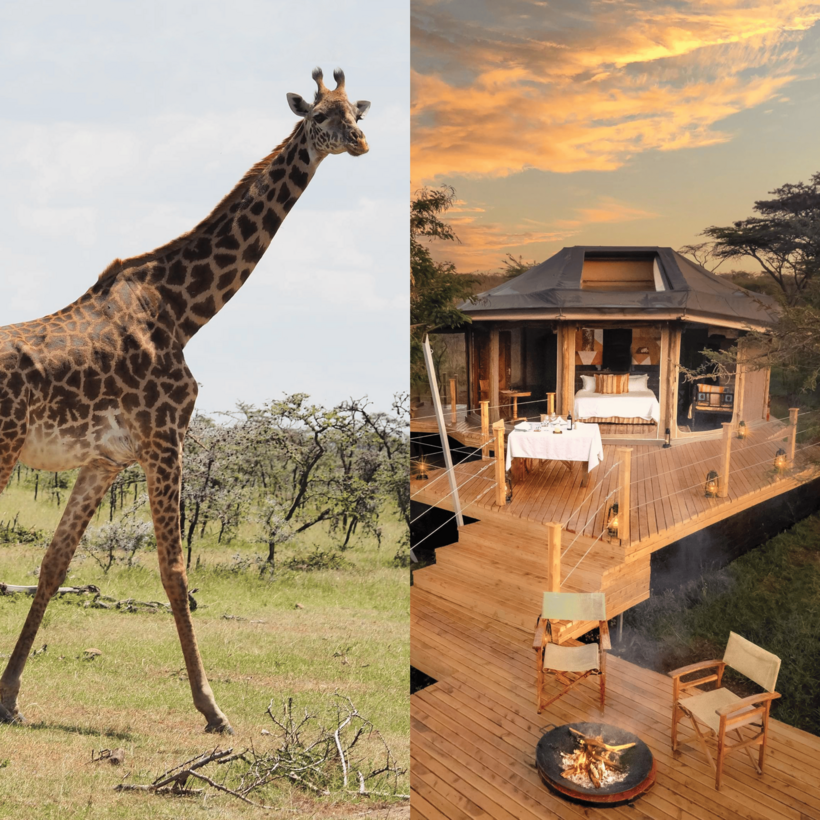On a late-afternoon game drive in the Naboisho Conservancy, in Kenya’s Maasai Mara, I had a wildlife encounter that Sir David Attenborough could have been narrating.
Not five yards from my vehicle, a pair of lions began to mate, a ritual that took about 10 seconds. Afterward, the female looked bored, and then, perking up at the grunts of nearby warthogs, hungry. She wanted dinner and rose to procure it. (Lionesses are the hunters in the pride.)
But the male wanted to mate again. “He is not happy,” said Manfred, one of my guides, as he read the dejected, annoyed expression on the lion’s face and in his body language.

In the savanna, it is never less than astonishing to find yourself face-to-face with the animal kingdom and absorbed into the unsentimental immediacy of birth, death, and everything in between.
On an eight-day safari at several properties belonging to Saruni Basecamp, which owns 13 camps and lodges in the Samburu and Maasai Mara regions of Kenya, I witnessed the full spectrum of life, reduced to its starkest elements.
A wildebeest was born, and it immediately wobbled to standing. An elephant calf was about to hurtle into river rapids until its mother scooped it to safety with her trunk. A bachelor impala, discarded by his herd, stood alone beneath a three-thorn-acacia tree. A giraffe carcass was splayed on the ground, her bones licked clean by hyenas. Above it all, lilac-crested rollers, red-throated wrynecks, and malachite kingfishers darted and sang.

In December, the end of the rainy season, the landscape was flush with water and new grass. Leopards stalked, gazelles leapt, and Cape buffalo grazed from first light to nightfall. After sunrise, the herbivores returned to the grasslands to munch happily again. “They are all celebrating surviving another night,” said Manfred. In the bush, a predator is always too close, and too famished.
Saruni Basecamp was formed in 2021, when Basecamp Explorer, which was founded by Norwegian owner Svein Wilhelmsen, acquired the Italian-owned Saruni luxury-camp group.
Its objective is to promote community-led conservation of both nature and native culture, providing a responsible, innovative tourism model while creating an extraordinary adventure in the African bush. On my safari, I experienced every conceivable wildlife sighting, including a solitary rhino emerging from a thicket during a thunderstorm, while staying in luxurious, environmentally minded accommodations among spectacular landscapes, such as Saruni Eagle View. There, my shiny new tent was decorated in warm creams and tangerines and featured a soaking tub with a vista of the grasslands and plains.

All the land on which the company operates its properties is owned entirely by the Maasai or Samburu people—the latter are semi-nomadic pastoralists, related to the Maasai, with whom they share a language. Their homeland, just above the equator, 300 miles from the Maasai Mara, looks much like the American Southwest, with desert scrubland and magical rock formations in the shapes of animals.
“They are all celebrating surviving another night.”
The local communities lease their lands for up to several years to Saruni Basecamp in the form of conservancies. As full partners, the communities reap the consequent economic benefits, which improve village life in multiple ways: better education, advanced health care, more opportunities for girls.

The conservancy model allows tribal landowners to actively help determine environmental practices on the terrain they know better than anyone else. For example, they graze their cattle only in designated areas, help decide where new construction is to be sited, and determine how many cars and camps a conservancy can hold. “The landowners don’t want overcrowding, because they want their land and eco-system to stay valuable,” Jeremiah Mutisya, the C.E.O. of Saruni Basecamp, told me over lunch in Nairobi.
Along with upholding this conservation-minded philosophy, Saruni Basecamp’s foundation, Basecamp Explorer, which has fundraising arms in Kenya, Norway, and the U.S., supports multiple community-development projects.

At the Enjoolata Center, I visited a workshop of nearly 200 women who make traditional beaded jewelry and met director Branice Yiamoi, a 29-year-old Maasai mother of three who has a master’s in public health. The income generated from their handiwork helps pay for schooling and, she says, “is starting to help eradicate the dominance of men in Maasai families.”
Approximately 90 percent of Saruni Basecamp–lodge employees (including safari guides) are native Maasai or Samburu, and the entire management team is Kenyan. For Nicole Nanetoi, the general manager of my first camp, Saruni Samburu, home is a village not far from the lodge. A breathtaking hilltop compound with 360-degree views of the Kalama Conservancy, it includes a menu of delicious offerings from a Samburu chef. Nanetoi told me that Mount Ololokwe, which dominates the landscape and changes color depending on the angle of the sun, is the most sacred site in her culture.

My Samburu guide, Joseph, was draped in bright cloth customary to his tribe. (Maasai, by contrast, wear blood reds.) After the rain, the air had an herbal-apothecary smell. While scouring rocky habitats for leopards and pointing out a gerenuk—an antelope with an ostrich-like neck, and one of five animals unique to the Samburu region—Joseph offered a master class in homeopathy.
He picked specimens of wild mint used for perfume; acacia nubica, which is useful for coughs; another acacia distilled for “female distress”; and a juicy twig from the antiseptic-tasting Salvadora-persica bush, the Samburu toothbrush.
Later, a bush plane took me south to the Mara, with a landscape in such stark contrast to the Samburu, “it may as well be in a different country,” my Maasai guide Senior told me. We set up our bush lunch not far from a cheetah mother accompanied by a tiny, yawning cub.

One morning, I woke before daybreak in my downy bed at Saruni Mara, my third lodging of the week, where my “room” was a handsome stone cottage furnished with leather chests and a lushly patinaed wood armoire. Soon, on the shore of a water hole packed with hippopotamuses, I breakfasted on yogurt, fresh mango, toast with pineapple marmalade, and chocolaty Kenyan coffee.
Just beyond, topi antelope mingled with zebra herds, their muscular bodies moving between rays of new sunshine. The air was pierced with the cackle of the hadada ibis.
At the elegant and earthy Saruni Leopard Hill, in the Mara Naboisho Conservancy, I met Manfred, my third and final guide. My tent had a retractable roof, through which I could see the diamond of Venus, the waning moon, and a shimmering wash of constellations from my bed. Outside, I heard braying baboons and the leopard call, a sound that resembles the back-and-forth of a saw slicing through wood.
Finally, Manfred ferried me across Naboisho to the newly renovated Saruni Eagle View. The camp’s infinity pool overlooks a salt lick, where animals bend to draw nutrients from the earth.

At teatime, I settled into a leather deck chair with a slice of passion-fruit layer cake and a cup of sweet rooibos tea. The camp manager, Sammy Lemiruni, joined me for a spell and told me of his childhood in a Samburu village, where he was twice bitten by a red spitting cobra. Below us, giraffes paraded across the rich, green world. It was a comfort to know that this view, and this slice of earth, will remain unspoiled.
“These conservancies allow the land to be preserved without being subdivided, farmed, grazed, deforested,” said Mutisya the next day in Nairobi. “If you protect the land, you are protecting the culture, and the next generation.”
Marcia DeSanctis is a contributing writer at Travel + Leisure and writes essays and stories for Vogue, Town & Country, Departures, and BBC Travel. Her collection of travel essays is called A Hard Place to Leave: Stories from a Restless Life


